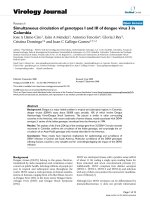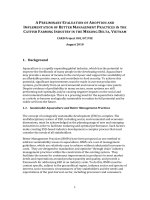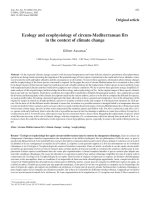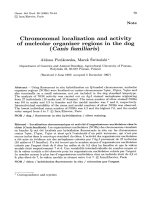Expression pattern and functions of dihydropyrimindase like 3 in the rodent microglia
Bạn đang xem bản rút gọn của tài liệu. Xem và tải ngay bản đầy đủ của tài liệu tại đây (5.46 MB, 191 trang )
EXPRESSION PATTERN AND FUNCTIONS OF
DIHYDROPYRIMIDINASE LIKE-3 IN THE
RODENT MICROGLIA
JANANI MANIVANNAN
NATIONAL UNIVERSITY OF SINGAPORE
2013
EXPRESSION PATTERN AND FUNCTIONS OF
DIHYDROPYRIMIDINASE LIKE-3 IN THE
RODENT MICROGLIA
JANANI MANIVANNAN, M.Sc.
A THESIS SUBMITTED FOR THE DEGREE OF
DOCTOR OF PHILOSOPHY
DEPARTMENT OF ANATOMY
YONG LOO LIN SCHOOL OF MEDICINE
NATIONAL UNIVERSITY OF SINGAPORE
2013
i
DECLARATION
I hereby declare that the thesis is my original work and it has been written by me
in its entirety. I have duly acknowledged all the sources of information which
have been used in the thesis.
This thesis has also not been submitted for any degree in any university
previously.
_______________
Janani Manivannan
ii
ACKNOWLEDGEMENTS
First, I would like to express my deepest appreciation to my supervisor Associate
Professor S.Thameem Dheen, Department of Anatomy, National University of
Singapore for his unstinted guidance and persistent support throughout my work.
He has been instrumental in both professional and scientific development of my
research career.
I would like to extend my warm thanks to Professor Bay Boon Huat, Head,
Department of Anatomy, for providing me an opportunity to pursue research at
this Department and also for his expert advice and suggestions during my study.
I am greatly indebted to Emeritus Professor Ling Eng-Ang, former Head, and
Associate Professor Samuel S.W. Tay, Deputy Head, Department of Anatomy,
National University of Singapore for their valuable advice and suggestions to my
research during the candidature.
I would like to thank Mrs. Ng Geok Lan, Mrs. Yong Eng Siang and Ms. Chan
Yee Gek for their technical assistance, Mdm. Ang Carolyne Lye Geck, Ms. Teo
Li Ching Violet and Mdm. Diljit Kaur for their secretarial assistance.
I must thank my labmates, Mr. Parakalan Rangarajan, Ms. Nimmi Baby, Ms.
Sukanya Shyamasundar and Ms. Shweta Jadhav for their help and valuable
suggestions during lab meetings. I had an opportunity to train Ms. Lina Farhana
(Honors student, NUS) for her final year project experiments and would like to
thank her for some contribution to the preliminary analysis of this project. I would
iii
also like to take this opportunity to thank Late Mr. Dhayaparan Devaraj for his
support and friendship.
I wish to thank the Yong Loo Lin School of Medicine, National University of
Singapore for the financial support by means of Research Scholarship. Research
grant support from National Medical Research Council (NMRC/EDG/1039/2011;
R-181-000-139-275) to A/P Dheen to carry out this present study, is gratefully
acknowledged.
Lastly, and most importantly, I thank my family (my parents, my brother and my
husband) for their love, care and support.
iv
Dedicated to my beloved family
v
TABLE OF CONTENTS
DECLARATION i
ACKNOWLEDGEMENTS ii
TABLE OF CONTENTS v
PUBLICATIONS xiii
SUMMARY xv
LIST OF TABLES xviii
LIST OF ILLUSTRATION/TEXT FIGURES xix
LIST OF SYMBOLS/ABBREVIATION xx
Chapter 1: Introduction 1
1.1 Central nervous system and its cell types 2
1.2 Microglia 2
1.3 Morphology of microglia 3
1.3.1 Amoeboid microglia 3
1.3.2 Ramified microglia 4
1.3.3 Activated microglia 4
1.4 Functions of microglia 5
1.4.1 Chemotaxis and migration of microglia 5
1.4.2 Phagocytosis 6
1.4.3 Proliferation 6
vi
1.4.4 Release of cytokines and reactive oxygen intermediates 7
1.5 Activation of microglia 11
1.5.1 Lipopolysaccharide (LPS) 11
1.5.2 Beta –Amyloid (Aβ) 12
1.6 Signaling pathways involved in microglial activation 12
1.6.1 Nuclear factor-κB pathway (NF-κB) 12
1.6.2 Mitogen-activated protein kinase pathways (MAPKs) 13
1.6.3 Rho family of guanosine triphosphatases GTPases (Rho GTPases) 13
1.7 Cytoskeleton organization in microglia 14
1.8 Microglial activation in neuropathologies 16
1.8.1 Microglial activation in Alzheimer’s disease 16
1.8.2 Microglial activation in Parkinson’s disease 17
1.8.3 Microglial activation in traumatic brain injury 17
1.9 Current approaches for controlling microglia activation 18
1.10 BV-2 microglial cells for in vitro experimental study 18
1.11 Global gene expression profiling of microglia 19
1.12 Collapsin Response Mediator Proteins (CRMPs) 20
1.12.1 Dihydropyrimidinase like-3 (Dpysl3) or Collapsin response mediator
protein-4 (CRMP4) - Gene Ontology predictions 21
1.13 Expression of Dpysl3 in different cell types 21
vii
1.13.1 Dpysl3 in the developing nervous system 21
1.13.2 Dpysl3 in adult nervous system 22
1.13.3 Dpysl3 in the peripheral nervous system 22
1.14 Function of CRMPs 22
1.14.1 CRMPs in neuronal development 22
1.14.2 CRMPs in pathological conditions 23
1.15 Signaling pathways involving Dpysl3 24
1.15.1 F-actin cytoskeletal bundling 24
1.15.2 Rho GTPase Regulators 25
1.16 Role of Dpysl3 in nerve regeneration 26
1.16 Aim of the study 27
1.16.1 To investigate the expression pattern and function of Dpysl3 in the
normal or resting and activated microglia 27
1.16.2 To examine the role of Dpysl3 in microglial migration, phagocytosis
and proliferation 28
1.16.3 To examine the role of Dpysl3 in cytoskeleton organization of
activated microglia 28
1.16.4 To investigate the role of Dpysl3 in Rho GTPases cytoskeletal
pathway 29
Chapter 2: Materials and Methods 30
2.1 Animals 31
viii
2.1.1 Injection of LPS 31
2.2 Perfusion 32
2.2.1 Materials 32
2.2.2 Procedure 32
2.2.3 Preparation of frozen sections 33
2.3 Cell culture 33
2.3.1 Primary microglial culture 33
2.3.2 BV-2 microglial cell culture 35
2.3.3 Treatment of BV-2 cells 36
2.4 siRNA mediated gene knockdown 37
2.4.1 Principle 37
2.4.2 Materials 37
2.4.3 Procedure 38
2.5 RNA isolation and quantitative reverse transcription-polymerase chain
reaction (qRT-PCR) 39
2.5.1 Principle 39
2.5.2 Materials 40
2.5.3 RNA extraction 41
2.5.4 cDNA Synthesis 42
2.5.5 Quantitative real-time -PCR 43
ix
2.5.6 Detection of PCR products 44
2.6 Western blotting 44
2.6.1 Principle 44
2.6.2 Materials 45
2.6.3 Procedure 47
2.6.4 Cytoplasmic and nuclear protein extraction 48
2.7 Immunohistochemistry and Immunofluorescence staining 49
2.7.1 Principle 49
2.7.2 Immunofluorescence labeling 50
2.8 in vitro migration assay 52
2.8.1 Materials 52
2.8.2 Procedure 53
2.9 Phagocytosis 53
2.9.1 Materials 53
2.9.2 Procedure 54
2.10 Nitric oxide assay 54
2.10.1 Principle 54
2.10.2 Materials 55
2.10.3 Procedure 55
2.11 Cell viability assay 56
x
2.11.1 Material 56
2.11.2 Procedure 56
2.12 BrdU assay 56
2.12.1Principle 56
2.12.2 Materials 57
2.12.3 Procedure 57
2.13 Co-Immunoprecipitation 58
2.13.1 Principle 58
2.13.2 Materials 58
2.13.3 Procedure 59
2.14 Quantitative analysis 60
2.15 Statistical analysis 60
Chapter 3: Results 61
3.1 Differential expression of Dpysl3 in the developing rat brain 62
3.2 Expression of Dpysl3 is increased in activated microglia 62
3.2.1 In LPS injected rat brains 62
3.2.3 Activated microglial cultures 63
3.3 Distribution of Dpysl3 in activated BV-2 microglia 64
3.4 Dpysl3 regulates the proinflammatory cytokines and neurotoxic mediators
in activated microglia through NF-κB signaling pathway 64
xi
3.4.1 siRNA knockdown of Dpysl3 64
3.4.2 Knockdown of Dpysl3 decreases the production of TNF-α cytokine by
activated microglia 65
3.4.3 Knockdown of Dpysl3 decreases the production of IL-1β cytokine by
activated microglia 66
3.4.4 Knockdown of Dpysl3 reduces the expression of iNOS expression in
activated microglia 66
3.4.5 Knockdown of Dpysl3 reduces production of nitric oxide in activated
microglia 67
3.4.6 Knockdown of Dpysl3 suppresses NF-κB transcriptional activity 67
3.5 Dpysl3 regulates F-actin cytoskeleton, migration, phagocytosis and
proliferation of microglia 68
3.5.1 Knockdown of Dpysl3 alters the structure of F-actin organization 68
3.5.2 Knockdown of Dpysl3 inhibits migration of microglia 69
3.5.3 Knockdown of Dpysl3 inhibits phagocytic ability of microglia 69
3.5.4 Knockdown of Dpysl3 reduces the proliferation of activated microglia
70
3.6 Interaction of Dpysl3with Rho GTPases 70
3.6.1 Interaction of Dpysl3 with RhoA 70
3.6.2 Interaction of Dpysl3 with Rac1 71
Chapter 4 :Discussion 73
xii
4.1 Dpysl3 is developmentally regulated in amoeboid microglia 74
4.2 Dpysl3 expression increases in activated microglia in vitro and in vivo 75
4.3 Dpysl3 knockdown attenuated the production of proinflammatory cytokines
and inflammatory mediators in activated BV-2 microglia 76
4.4 NF-κB pathway is involved in Dpysl3 mediated microglial activation 77
4.5 Dpysl3 regulates cytoskeletal dynamics in activated microglia 78
4.6 Dpysl3 knockdown reduces microglial migration 79
4.7 Dpysl3 knockdown reduces microglial proliferation 79
4.8 Dpysl3 knockdown reduces the phagocytic activity of activated microglia 80
4.9 Rho GTPases: RhoA and Rac1 pathways are involved in Dpysl3 mediated
microglial activation 81
4.9.1 RhoA in Dpysl3 mediated microglial activation 81
4.9.2 Rac1in Dpysl3 mediated microglial activation 82
Chapter 5: Conclusion and Scope for future studies 84
5.1 Conclusion 85
5.2 Scope for future studies 88
References 90
Figures and Figure legends 117
xiii
PUBLICATIONS
International Journals:
1. Manivannan Janani, Samuel SW Tay, Eng-Ang Ling, and *S.Thameem
Dheen (2013). Dihydropyrimidinase like 3 regulates the inflammatory
response of microglia. Neuroscience 253:40-54.
2. Rangarajan Parakalan, Boran Jiang, Baby Nimmi, Manivannan Janani,
Manikandan Jayapal, Jia Lu, Samuel SW Tay, Eng-Ang Ling and S.
Thameem Dheen (2012). Transcriptome analysis of amoeboid and
ramified microglia isolated from the corpus callosum of rat brain. BMC
Neuroscience 13:64.
Conference presentations:
I. Oral presentation
1. J.Manivannan, E.A.Ling, S.S.W.Tay and *T. Dheen. Role of
Dihydropyrimidinase like 3 in regulating the inflammatory response of
activated microglia in “Society for Neuroscience Conference 2012”,
13
th
-17
th
Oct 2012, New Orleans, USA.
II. Poster Presentations
1. Janani Manivannan, Eng-Ang Ling and S. Thameem Dheen.
Dihydropyrimidinase like 3 regulates the inflammatory response of
activated microglia, Singapore Neuroscience Association (SNA)
Symposium 2013, 26
th
April 2013, Centre for Life Science, National
University of Singapore, Singapore.
2. Janani Manivannan, Eng-Ang Ling and S. Thameem Dheen.
Dihydropyrimidinase like 3 in regulating the inflammatory response of
activated microglia, Yong Loo Lin School of Medicine 3
rd
Annual
xiv
Graduate Scientific Congress, 30
th
January 2013, National University
of Singapore, Singapore.
3. Janani Manivannan, Eng-Ang Ling and S. Thameem Dheen. Role of
Dihydropyrimidinase like 3 in regulating the inflammatory response of
activated microglia”, Singapore Neuroscience Association (SNA)
Symposium 2012, 19
th
April 2012, National University of Singapore,
Singapore.
4. Eng-Ang Ling, Janani Manivannan, Lu Jia and S. Thameem Dheen.
Expression of Dihydropyrimidinase-like 3 in Amoeboid Microglia in
Postnatal Rat Brain and in the Activated Microglia in Traumatic Brain
Injury”, Ninth World Congress on Brain Injury, 21
st
-25
th
March 2012,
Edinburgh, Scotland, UK
5. Janani Manivannan, Eng-Ang Ling and S. Thameem Dheen. “A
study on the expression and function of Dihydropyrimidinase like 3 in
activated microglia”, Yong Loo Lin School of Medicine 2
nd
Annual
Graduate Scientific Congress, 15
th
February 2012, National University
of Singapore, Singapore.
III. Award
Best graduate overseas oral presentation award by the Yong Loo Lin
School of Medicine on 30
th
January 2013 at Annual Scientific Graduate
Congress, Centre for Life Science, National University of Singapore,
Singapore.
xv
SUMMARY
Microglia, which are the resident immune cells of the central nervous system,
become activated in response to stress, injury, infection and inflammation.
Activation of microglia results in excessive production of proinflammatory
cytokines and neurotoxic factors that underlie several neuropathological
conditions. Further, the activated microglia undergo morphological
transformation, rapid proliferation, and directed migration (to the affected region)
which are regulated by the actin cytoskeleton organization. It was hypothesized
that genes controlling cytoskeleton organization are involved in microglial
activation. Determination of factors that inhibit microglial activation has been
considered to be an important therapeutic strategy for various inflammatory and
neurodegenerative diseases.
Dihydropyrimidinase-like 3 (Dpysl3), a member of collapsin response
mediator protein family, is known to directly regulate the F-actin cytoskeleton. In
this study, the roles of Dpsyl3 on the inflammatory reaction of activated microglia
have been investigated. Microarray analysis comparing the global gene expression
profile of amoeboid and ramified microglia has shown that Dpysl3 is mainly
expressed in amoeboid microglia in the 5-day postnatal rat brain.
Immunohistochemical analysis revealed that Dpysl3 was intensely expressed in
amoeboid microglial cells until postnatal day 7, and then gradually diminished in
ramified microglia (postnatal day 14). Further, in vitro analysis confirmed that the
expression of Dpysl3 was induced in activated BV-2 microglial cells by LPS. It is
well documented that microglial activation increases the expression of iNOS and
xvi
proinflammatory cytokines through activation of NF-κB activity. In the present
study, siRNA-mediated knockdown of Dpysl3 prevented the LPS-induced
expression of iNOS and cytokines including IL-1β, and TNF-α as well as nuclear
translocation of NF-κB in microglia, indicating that Dpysl3 promotes the
proinflammatory response of activated microglia.
Dpysl3 was found to be localized with F-actin cytoskeleton which is
essential for cell motility and phagocytosis. Knockdown of Dpysl3 inhibited the
migration and the phagocytic ability of activated microglia coupled with deranged
actin filament configuration, suggesting that Dpysl3 regulates the microglial
activation by altering their migration and phagocytic ability through the actin
cytoskeleton rearrangement. This was further confirmed since the knockdown of
Dpysl3 attenuated the expression of Rho GTPase cytoskeletal proteins such as
RhoA and Rac1, which have been shown to regulate inflammatory and oxidative
responses in activated microglia.
In summary, the present study demonstrated the mechanism by which
Dpysl3 regulates the inflammatory response of activated microglia. Dpysl3 is
developmentally regulated in amoeboid microglia and its expression is increased
in activated microglial cells. Further, Dpysl3 knockdown in activated microglia
altered the expression of proinflammatory cytokines such as TNF-α and IL-1β and
inflammatory mediators including iNOS and NO and the migratory and
phagocytic ability of activated microglia, possibly by regulating NF-κB and Rho
GTPase signaling pathways.
xvii
Overall, this study describes that Dpysl3 not only functions as a
cytoskeletal gene but also acts as a novel regulator for inflammatory response,
migration and phagocytosis of activated microglia. Although this study
demonstrates the potential function of Dpysl3 in activated microglia, further
studies using in vivo animal models such as Dpysl3 knockout mice and
Alzheimer’s disease mice, would be required to understand its functions in
neuropathological conditions.
xviii
LIST OF TABLES
Table I: Number of rats used for various experimental groups 31
Table II: Dpysl3 siRNA construct sequences 38
Table III: Primer sequences for RT-PCR 43
xix
LIST OF ILLUSTRATION/TEXT FIGURES
Figure I: Diagrammatic representation of different morphology of microglia. 5
Figure II: Confocal image show the immunoexpression of F-Actin (red) in control
and LPS-treated BV-2 microglia. 15
Figure III: Volcano plot represents the differential expression of Dpysl3 in
amoeboid and ramified microglia. 19
Figure IV: An illustration demonstrates the functional events of
Dihydropyrimidinaselike-3 in activated microglia 87
xx
LIST OF SYMBOLS/ABBREVIATION
AMC: Amoeboid microglial cells
Aβ: β-Amyloid
BrdU: 5-Bromo-2’-deoxyuridine
CNS: Central nervous system
Co-IP: Co-Immunoprecipitation
CRMPs: Collapsin response mediator proteins
DAPI: 4', 6-diamidino-2-phenylindol
DMEM: Dulbecco's Modified Eagle Medium
DMS: N, N-dimethylsphingosine
Dpysl3: Dihydropyrimidinase like-3
F-actin: Filamentous actin
FBS: Fetal bovine serum
HRP: Horseradish peroxidase
IF: Immunofluorescence
IHC: Immunohistochemistry
IL-1β: Interleukin-1 beta
iNOS: Inducible nitric oxide synthase
LPS: Lipopolysaccharide
MS: Multiple sclerosis
NF-κB: Nuclear factor kappa-light-chain-enhancer of activated B cells
NO: Nitric oxide
PBS: Phosphate-buffered saline
xxi
PD: Parkinson’s disease
PF: Paraformaldehyde
PVDF: Polyvinylidene fluoride
Rac1: Ras-related C3 botulinum toxin substrate 1
RhoA: Ras homolog gene family, member A
RMC: Ramified microglial cells
ROS: Reactive oxygen species
RT: Room temperature
RT-PCR: Reverse transcription-polymerase chain reaction
SDS-PAGE: Sodium dodecyl sulphate- polyacrylamide gel electrophoresis
SDS: Sodium dodecyl sulphate
TBI: Traumatic brain injury
TBS: Tris buffered saline
TBST: TBS with 0.1% tween- 20
TEMED: Tetramethylethylenediamine
TNF-α: Tumor necrosis factor-alpha
Introduction
1
Chapter 1
Introduction
Introduction
2
1.1 Central nervous system and its cell types
The central nervous system (CNS) comprises of the brain and spinal cord which
contain two main cell types, neurons and the glial cells (Carnevale et al., 2007).
Glial cells mainly provide support and protection to the neurons. In addition, glial
cells play essential roles in neuronal development, plasticity and recovery from
injury (Brown and Neher, 2010).The three main Glial cell types in the central
nervous system includes microglia, astrocytes and oligodendrocytes (Jessen and
Mirsky, 1980).
1.2 Microglia
Microglia were described as the macrophage-like cells in 1919 by Spanish
neuroscientist Rio-Hortega (Pessac et al., 2001; Kettenmann et al., 2011).
Microglia are the resident immune cells of the CNS, represent approximately 5-
10% of total Glial cell population in the CNS. They respond to injuries and
infections in the CNS, by producing proinflammatory cytokines and performing
phagocytosis of cellular debris and pathogens (Guillemin and Brew, 2004;
Kettenmann et al., 2011).
Inflammatory response to injury or stimulation (by a chemical or
biological agent) in the CNS is a complex process, which initiates a series of
signaling events. The inflammatory response occurs mainly to remove the
invading microorganisms as well as the toxic agents thereby resulting in repair
and healing (Wyss-Coray and Mucke, 2002; Wyss-Coray, 2006). The process of
neuroinflammation is instigated primarily by microglia (Kettenmann et al.,









